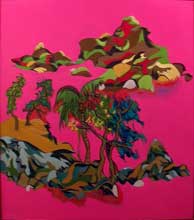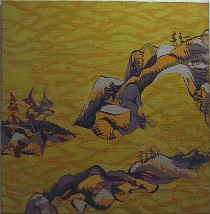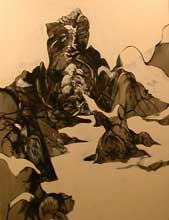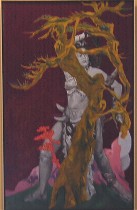 I’ve been working my way up to Miguel Trelles’ exhibit at Taller Puertorriqueno every since Roberta wrote her informative post on it. I’m happy to report that not only did I get there, but it was worth the effort (image, “Canaries Landscape,” 54 x 52 inches, oil on canvas).
I’ve been working my way up to Miguel Trelles’ exhibit at Taller Puertorriqueno every since Roberta wrote her informative post on it. I’m happy to report that not only did I get there, but it was worth the effort (image, “Canaries Landscape,” 54 x 52 inches, oil on canvas).Although Roberta was pretty comprehensive, I thought I’d add a few thoughts about the Chino-Latino landscapes.
I was struck by the way the land is sensual, suggesting bodies and tropical vegetation.
 The colors go beyond mere tropical. They also have a cultural zing to them. After all, I wouldn’t respond to them as African tropical or as Hawaiian tropical colors. (I’m thinking here of Rebecca Rutstein‘s intense, mappy Hawaii images–see Roberta’s piece here on Rutstein’s show that just closed at Bridgette Mayer Gallery. Rutstein evokes some of the same island and lava phenomena, but has a different intent–an effort to take control by mapping. For all her hot palette in this body of work, she does not show that love of heat and abandonment to color that Trelles has)(image left, “Yellow Lava,” 36 x 35 1/2 inches, oil).
The colors go beyond mere tropical. They also have a cultural zing to them. After all, I wouldn’t respond to them as African tropical or as Hawaiian tropical colors. (I’m thinking here of Rebecca Rutstein‘s intense, mappy Hawaii images–see Roberta’s piece here on Rutstein’s show that just closed at Bridgette Mayer Gallery. Rutstein evokes some of the same island and lava phenomena, but has a different intent–an effort to take control by mapping. For all her hot palette in this body of work, she does not show that love of heat and abandonment to color that Trelles has)(image left, “Yellow Lava,” 36 x 35 1/2 inches, oil).And speaking of love of heat and abandonment to color, these islands abandon their inhibitions to the sea and vice versa. The vivid ocean in these paintings interlocks with the land masses. They embrace like lovers or the pieces in a jigsaw. And the ocean seems less like a barricade between the landmasses and more like a yin to the land’s yang.
 Just in case you didn’t get how imaginary Trelles’ lands are, he also offers up a pair of paintings about the same “landscape,” one in a horizontally striped sea, one in a vertically striped sea (right, “Yauco Landscape,” oil on linen, 48 x 48 inches).
Just in case you didn’t get how imaginary Trelles’ lands are, he also offers up a pair of paintings about the same “landscape,” one in a horizontally striped sea, one in a vertically striped sea (right, “Yauco Landscape,” oil on linen, 48 x 48 inches).  In the black and white paintings, Trelles adapts the scroll length to Western art conventions, using a triptych in one case, a long canvas in another. But Trelles’ scrolls do not have that sense of storytelling and time that underlie traditional Chinese scrolls (according to one of the essays at the gallery, Trelles, who studied Chinese art history for a while, admired the work of Ming Dynasty artist Tung Ch’i Ch’ang) (left, “Approximation to Nelson’s Sphinx,” charcoal, ink, acrylic and oil on canvas, 30 x 148 inches total).
In the black and white paintings, Trelles adapts the scroll length to Western art conventions, using a triptych in one case, a long canvas in another. But Trelles’ scrolls do not have that sense of storytelling and time that underlie traditional Chinese scrolls (according to one of the essays at the gallery, Trelles, who studied Chinese art history for a while, admired the work of Ming Dynasty artist Tung Ch’i Ch’ang) (left, “Approximation to Nelson’s Sphinx,” charcoal, ink, acrylic and oil on canvas, 30 x 148 inches total).  Trelles’s long paintings adapt gestural Asian inking, adding a variety of Western art-making strategies –charcoal and oil and sometimes acrylic. He uses the natural canvas as a color amidst the whites, grays and blacks (right, “Bones of Charcoal”).
Trelles’s long paintings adapt gestural Asian inking, adding a variety of Western art-making strategies –charcoal and oil and sometimes acrylic. He uses the natural canvas as a color amidst the whites, grays and blacks (right, “Bones of Charcoal”).In these, the rocky outcroppings appear to be rocks rising out of the land or the sand, rather than islands rising out of the sea.
 The Rumberas in the Garden series of portraits of dancer-actresses who dominated a stream of Mexican movie making in the 1950s, like the landscapes, have an underlying theme of exotic fantasies and sexiness, but they are fantasies of the past. They are also fantasies of another medium, cinema, and of other men (left, a portrait of the Cuban-born rumbera Amalia Aguilar).
The Rumberas in the Garden series of portraits of dancer-actresses who dominated a stream of Mexican movie making in the 1950s, like the landscapes, have an underlying theme of exotic fantasies and sexiness, but they are fantasies of the past. They are also fantasies of another medium, cinema, and of other men (left, a portrait of the Cuban-born rumbera Amalia Aguilar).
In the Garden of the Forking Paths group of landscapes, however, the exotic fantasies seem present and fresh and Trelles’ own. Trelles, who is Puerto Rican with Cuban roots, works in Brooklyn and New Haven.trelles, miguel









